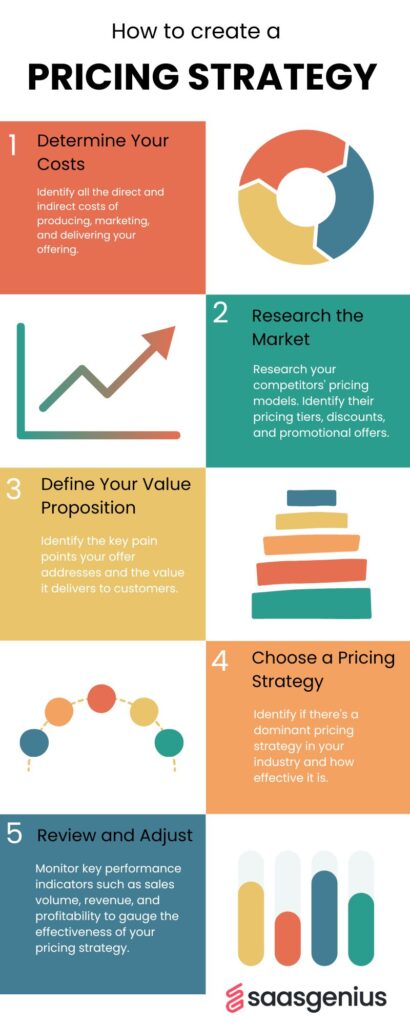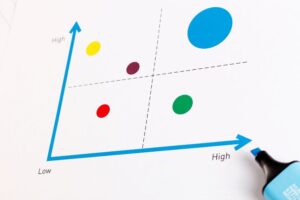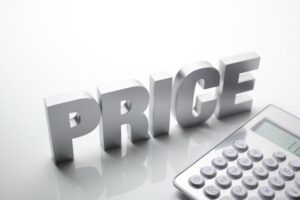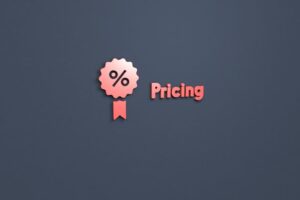Have you ever wondered how businesses determine the prices of their services or products? They usually take a well-defined approach to arrive at those numbers. This approach is known as a pricing strategy, and it’s a crucial element that largely determines the success of a product or service.
According to a study, about 82% of customers compare prices between competitor brands before making any buying decision. So you must nail this aspect of your business to succeed.
This article explores everything you need to know about a pricing strategy. You’ll discover the different types of pricing strategies, why they are important, and the factors that influence them. You’ll also learn how to develop a profitable pricing strategy for your business.
Pricing Strategy Definition
A pricing strategy is a method used to determine the optimal price for a product or service. It involves considering various factors, such as production costs, competition, customer perception, and market demand, to set a price.
A pricing strategy aims to strike a balance between generating a profit and remaining attractive to consumers. To do this, you must align the price with the product’s perceived value and the business’s financial objectives.

Pricing Strategy Examples
Types of Pricing Strategies
Different industries and market conditions often require different pricing strategies to achieve success. Some of the most common pricing strategies include:
- Market-based pricing,
- Value-based pricing,
- Cost-based pricing,
- Psychological pricing,
- Skimming pricing,
- Dynamic pricing.
1. Market-based Pricing
Best For: New products or companies looking to break into a highly-competitive industry.
This strategy involves setting prices based on the current market conditions. Here, businesses conduct market research to determine the average price range for similar products or services and adjust their prices accordingly.
The goal is to set a price that aligns with what customers are willing to pay for similar products or services. This approach enables businesses to remain competitive.
However, they must carefully balance market-based pricing with cost considerations and profit goals to ensure long-term sustainability.
MORE: What is competitive pricing?
2. Value-based Pricing
Best For: Products or services with clear differentiation between them and competitors’. In other words, it is useful for highly valuable and unique products and services.
Value-based pricing revolves around customers’ perceived value of your product or service. Instead of focusing solely on costs or market prices, this approach considers the benefits and outcomes customers expect from your offerings.
The value customers derive from a product or service can be subjective and may include increased efficiency, time savings, convenience, improved performance, or enhanced quality.
It is highly effective when customers are willing to pay a premium for unique features or solutions.
3. Cost-based Pricing
Best For: Industries with well-defined and stable cost structures, such as manufacturing.
Cost-based pricing is one of the most straightforward approaches to pricing. In this approach, businesses determine the price of their products or services by considering the production costs involved in creating them.
After calculating the total cost, they add a predetermined profit margin, typically a percentage of the total cost.
However, relying solely on costs might result in setting prices too high for the market to bear or missing out on opportunities to capture higher value from customers willing to pay more.
MORE: What is economy pricing and when to use it?
4. Psychological Pricing
This strategy leverages human psychology and behavior to influence consumers’ perception of price and, ultimately, their purchasing decisions. Here are some of the different aspects of psychological pricing:
- Odd-even pricing: Odd-numbered prices (e.g., $7.95) creates the perception of a discount or bargain price, while even-numbered prices (e.g., $8.00) may appear costlier even if the difference is minimal.
- Charm pricing: This involves setting prices just below a round number, such as pricing a product at $9.99 instead of $10 to create the illusion that it’s significantly lower than it actually is.
- Prestige pricing: Premium or luxury products are often priced higher intentionally to convey exclusivity and superior quality. Luxury fashion brands such as Chanel, Prada, and Louis Vuitton are classic examples of companies using prestige pricing.
Other psychological pricing models include bundle pricing, decoy pricing, and price anchoring. Exploiting these models can help you enhance perceived value, encourage purchases, and create a positive emotional connection between the consumer and the product.
5. Skimming Pricing
Best For: Introducing innovative or technologically advanced offerings with a limited target market.
Skimming pricing focuses on setting a high initial price for a new product or service. By setting a premium price, they can maximize their revenue from the early adopters willing to pay a higher price for early access.
Apple Inc. is the most popular user of this strategy. Whenever Apple releases a new product, such as the iPhone or the MacBook, they set a high initial price to target early adopters and those willing to pay a premium price for the latest devices. As time passes, they lower the price to attract more customers and increase sales volume.
6. Dynamic Pricing
Best For: Companies in the travel, hospitality, and e-commerce sector, where prices fluctuate significantly.
This strategy involves adjusting prices in real time based on demand & supply, seasonality, or customer behavior.
Businesses in the sector mentioned above use sophisticated algorithms and data analysis to determine the optimal price at any time. This enables them to respond to market shifts quickly, maximize revenue during peak periods, and potentially offer discounts during slower times to stimulate demand.
MORE: Learn about other pricing strategies like captive product pricing strategy.
Factors Influencing Pricing Strategies
Several factors influence pricing strategies. These factors can be broadly categorized into internal and external factors.
Internal Factors
- Costs: Businesses must ensure their prices cover costs and offer a reasonable profit margin.
- Business goals: A company’s goals and objectives can influence its pricing strategy. For example, a business aiming to penetrate a new market may set lower prices initially to gain market share.
- Product positioning: Premium products may command higher prices, while budget products may focus on lower prices.
External Factors
- Market demand: Higher demand encourages higher prices, while lower demand may necessitate lower prices to stimulate sales.
- Competitive landscape: A business may match or undercut competitors’ prices to gain a competitive advantage.
- Economic conditions: The state of the economy, including inflation and purchasing power, can impact pricing strategies. During economic downturns, businesses may need to cut prices to remain competitive.
SaaS Pricing Models
SaaS companies typically offer their software subscriptions, and pricing models can vary significantly. Here are some common SaaS pricing models:
- Per-user pricing: This model charges customers based on the number of users with access to the software. It is commonly used for collaboration and productivity tools.
- Tiered pricing: In tiered pricing, businesses offer different pricing tiers with varying features and functionality. Customers can choose the tier that best suits their needs.
- Usage-based pricing: This model charges customers based on their software usage, such as the number of transactions processed or the amount of data stored.
- Freemium pricing: Freemium pricing offers a basic version of the software for free, with additional features available for a fee. It allows customers to try the software before committing to a paid plan.
- Enterprise pricing: This model is tailored for large organizations and typically involves custom pricing based on the specific needs and requirements of the customer.
How to Create a Pricing Strategy
Here are some steps to help you create an effective pricing strategy:
1. Determine your Costs
To set a profitable price for your product or service, you must figure out how much it costs to bring it into the market. Start by identifying all the direct and indirect costs associated with producing, marketing, and delivering your offering.
Direct costs include raw materials, labor, and production expenses, while indirect costs include overheads such as rent, utilities, and administrative expenses.
Once you have a comprehensive list of costs, calculate the breakeven point (the minimum amount you need to cover your expenses). This figure will serve as a foundation for setting a profitable price.
2. Research the Market
Research your competitors’ pricing models. Identify their pricing tiers, discounts, and promotional offers. This step will give you insights into the prevailing market price and help you effectively position your product or service.
You must evaluate how sensitive they are to price changes and how willing they are to pay a premium for added value. Conduct surveys, interviews, or focus groups to gather insights into their buying behavior, expectations, and value perceptions.
3. Define Your Value Proposition
A strong value proposition is the cornerstone of an effective pricing strategy. Clearly articulate the unique benefits and advantages your product or service offers compared to alternatives in the market. Identify the key pain points your offering addresses and the value it delivers to customers.
Highlight the quality, convenience, speed, customization, or superior customer service. These features will help differentiate your offering in the market and justify a higher price point.
4. Choose a Pricing Strategy
There are various pricing strategies, and the right one for your business depends on your industry, target market, and competitive landscape. What pricing strategies do your competitors, market leaders, and emerging players use? Identify if there’s a dominant pricing strategy in your industry and how effective it is.
Once you’ve set a base price, consider conducting A/B testing to compare different pricing models on a smaller scale. This allows you to gauge customer responses and measure the impact on sales and revenue.
MORE: Is geographical pricing the right strategy for your business?
6. Review and Adjust
Finally, monitor key performance indicators such as sales volume, revenue, and profitability to gauge the effectiveness of your pricing strategy. Seek customer feedback through surveys or reviews to understand their perception of your pricing and value proposition.
Stay agile and be willing to adapt to changing market conditions and customer preferences.

Benefits of a Pricing Strategy
An efficient pricing strategy is essential for many reasons. Here are some ways you can benefit from having one:
- It clearly establishes the value of a product or service, hence it’s easier to communicate and justify the price to potential customers.
- Pricing strategies help maximize revenue and profitability by finding the optimal balance between price and demand.
- Effective pricing strategies can foster customer loyalty and repeat business. For example, offering discounts or loyalty programs to returning customers can incentivize them to continue buying from the company.
- Sometimes, pricing strategies can help companies gain a competitive advantage in the market, especially when it targets different market segments.
- A well-defined pricing strategy can help businesses better manage costs and improve profit margins.
Key Takeaways
Selecting the most appropriate pricing strategy for your business requires careful consideration of various factors. It is essential to evaluate each pricing strategy based on its merits and drawbacks and compatibility with your business goals. Although you can try out different pricing strategies, starting with the popular ones in your industry is best.
For more SaaS pricing information and tools, visit our SaaS pricing website.
Related Posts
Frequently Asked Questions (FAQ)
Author
Methodology
- Who?
We are SaaS experts: Our specialists constantly seek the most relevant information to help support your SaaS business. - Why?
We are passionate about users accessing fair SaaS pricing: We offer up-to-date pricing data, reviews, new tools, blogs and research to help you make informed SaaS pricing decisions. - How?
With accurate information: Our website manager tests each software to add a Genius Score using our rating methodology to each product. Our editorial team fact-check every piece of content we publish, and we use first-hand testing, value metrics and leading market data.










